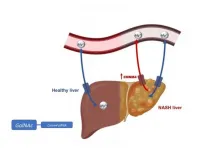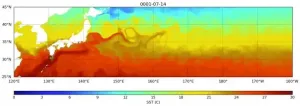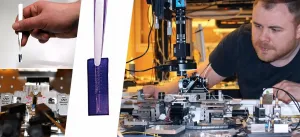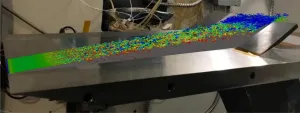Scientists adapt solar energy technology to detect chemical warfare agents & pesticides
Researchers are harnessing next-generation photovoltaics materials to create a fast, accurate testing mechanism for harmful compounds
2021-03-04
(Press-News.org) In a colourful solution to a dangerous problem, Australian scientists are adapting a component from cutting-edge solar cells to design a rapid, light-based detection system for deadly toxins.
While use of chemical warfare agents like sulfur mustard - better known as mustard gas - is banned internationally, we do rely on other strictly-controlled chemicals for agriculture, industry and throughout our daily lives, including fumigants like methyl iodide, which is used to control insects and fungi. The wrong amounts or incorrect use of these fumigants can be harmful to people and degrade the ozone layer.
Because it's invisible and doesn't smell, it's hard to tell whether there are dangerous amounts of methyl iodide present, and until now the best way to test for it was in a laboratory using expensive, complicated equipment, which isn't practical in many real-world settings. Some cheaper, lightweight detection methods have been tried, but they didn't have enough sensitivity and took too long to deliver results.
Now, research led by the ARC Centre of Excellence in Exciton Science has found a way to detect methyl iodide through changes in colour, with - for the first time - the accuracy, flexibility and speed necessary for practical use. Importantly, this new sensing mechanism is versatile enough for use in detecting a wide range of fumigants and chemical warfare agents.
Working with Australia's national science agency CSIRO and the Department of Defence, the researchers borrowed some new technology that's being used to improve solar power - synthetic nanocrystals based on a perovskite structure - and turned it into a detection method.
Their approach relies on the fact that these highly fluorescent nanocrystals react with the fumigant causing a change in the colour of the light they emit. The presence of methyl iodide causes the nanocrystal emission to shift from green to yellow, and then on to orange, red, and finally deep red, depending on the amount of fumigant present.
"Perovskite nanocrystals have proved to be a very efficient light emitter," lead author Dr Wenping Yin of Monash University said.
"Here we showed that methyl iodide can react with such perovskites, and do so very quickly following a simple chemical activation step. Critically, this activation step cuts the response time of the sensor from a few hours to just a few seconds."
In this process, the ions forming the nanocrystals change quickly when they are exposed to the methyl iodide triggered by a chemical reaction.
The reaction involves exchanging bromide with iodide within the nanocrystal itself, which results in the colour change.
Ultimately, the researchers have been able to demonstrate that the change in colour is dependent on the perovskite nanocrystal and methyl iodide concentrations.
"Although the chemical mechanism is very complicated, the outcome is just a colour change of the light produced by the nanocrystals, which is very easy to detect," Wenping said.
The new mechanism has the widest range, highest sensitivity and quickest response ever achieved for a technique that doesn't rely on expensive laboratory instrumentation, producing its results in around five seconds at room temperature.
The researchers now hope their findings will provide a platform for building a test device that can be used in real-world applications.
Senior author Professor Jacek Jasieniak said: "We've understood the foundational mechanism for what's needed to undergo this colourimetric sensing. Now it's about building a prototype sensing device.
"It needs further development to realise its true potential for broader detection of different types of methyl halide species, as well as pesticides and chemical warfare agents, like teargas, and mustard gas, but the stage is set."
Defence scientist and Industry Partner Investigator, Dr Genevieve Dennison said: "We are very excited about the potential demonstrated by this work and are looking forward to applying the technology to protect our military and first responders."
INFORMATION:
[Attachments] See images for this press release:
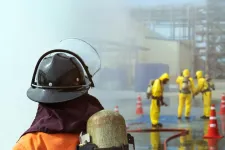
ELSE PRESS RELEASES FROM THIS DATE:
2021-03-04
An international team of researchers has identified the CNNM4 protein as a key regulator of magnesium in the liver and potential therapeutic target for non-alcoholic fatty liver disease, according to a study published in the Journal of Hepatology.
Non-alcoholic steatohepatitis, a form of fatty liver disease characterized by inflammation and liver fibrosis, is associated with obesity and has a worldwide prevalence of 1.7 billion people.
Unhealthy nutritional habits and dietary imbalances are recognized as causes of many diseases. Magnesium is widely available in both plant and animal foods; most vegetables, legumes, peas, beans, and nuts are rich in magnesium, as are some ...
2021-03-04
An exquisitely detailed global ocean model simulation from the National Center for Atmospheric Research (NCAR) has given scientists rare insight into where baby sea turtles may go in their "lost years" after they scramble off the sandy beaches where they are born and swim into the open ocean.
This look at a critically important period in the life cycle of endangered loggerhead turtles could help inform more comprehensive conservation efforts that encompass regions of the open ocean where young turtles grow, and not just the nesting beaches. It also pinpoints regions of the ocean that are important to study to better understand how to protect sea turtles. ...
2021-03-04
DALLAS, March 4, 2021 -- The rate of cardiovascular risk factors among Hispanic/Latino people living in the U.S. is very high, and while they are often aware of their health conditions, less than half of the Hispanic/Latino adults with history of stroke or transient ischemic attack (TIA) had healthy blood pressure and cholesterol, and about half had healthy blood sugar levels, according to new research published today in Stroke, a journal of the American Stroke Association, a division of the American Heart Association.
According to the American Heart Association, from 2015 to 2018, 52.3% of Hispanic men and 42.7% of Hispanic women aged 20 years and older had cardiovascular disease (CVD).
"It's a wake-up call for ...
2021-03-04
Bottom Line: Cancer survivors had a greater risk of reduced ambulatory function, which was associated with an increased risk of death.
Journal in Which the Study was Published: Cancer Epidemiology, Biomarkers & Prevention, a journal of the American Association for Cancer Research
Author: Elizabeth Salerno, PhD, MPH, assistant professor of surgery at Washington University School of Medicine in St. Louis, who conducted the research at the National Cancer Institute
Background: The diagnosis and treatment of cancer has been shown to be associated with poor functional health for common cancer types, such as those of the breast and prostate, but less is known about the association for other cancers, explained Salerno. "Given that cancer survivors are living longer than ever, ...
2021-03-04
A new study led by Washington University School of Medicine in St. Louis and the National Cancer Institute (NCI) has identified an association between slow walking pace and an increased risk of death among cancer survivors.
While the study does not establish that slow walking is a cause of death, the association persisted across at least nine tumor types. Investigators now call for more research into these relationships and whether targeted interventions such as physical activity programs could help cancer survivors improve their ability to walk and increase survival after cancer diagnosis and treatment.
The study, a collaboration between Washington University, the NCI of the ...
2021-03-04
The loss of seagrass in the waters around the UK is much higher than previously estimated. A new study published in Frontiers in Plant Science concludes that, with high certainty, at least 44% of the UK's seagrasses have been lost since 1936, of which 39% has been since the 1980s. This study is one of the first of its kind to bring together seagrass data from diverse sources and give a systematic estimate of the current and historic extent of seagrass, as well as seagrass loss in the UK.
The study was a collaboration between researchers at University College London, Kings College London, and Swansea University.
Seagrasses as climate change superheroes
Nature-based solutions are essential to mitigate the effects of the climate crisis, and seagrasses are highly ...
2021-03-04
(Boston)--Children in Zambia under age 5 die at a rate that is between nearly six to more than 10 times higher than those in the U.S; it is estimated at 40-75 per 1000, compared to 6.98 per 1000. Identifying why these children are dying is the mission of Rotem Lapidot, MD, assistant professor of pediatrics at Boston University School of Medicine (BUSM).
"Significantly, over 80 percent of all community infant deaths involved some form of delay. While it is impossible to know what would have occurred in the absence of such delays, the majority of infant deaths in Lusaka, the capital of Zambia, are from causes for which effective treatments currently exist," explained Lapidot, the corresponding author on the study ...
2021-03-04
The far-reaching mobility restrictions at the beginning of the Corona pandemic in March 2020 created a unique situation for atmospheric sciences: "During the 2020 lockdown, we were able to directly investigate the actual effects of drastic traffic restrictions on the distribution of air pollutants and on the emission of climate gases," says Innsbruck atmospheric scientist Thomas Karl. With his team, he has now published a detailed analysis of air quality during the first lockdown in the city of Innsbruck, Austria, in the journal Atmospheric Chemistry and Physics. "We find significantly greater decreases of air pollutants than of carbon dioxide, for example," the researcher says, summarizing the results. In the past year, some studies showed contradicting ...
2021-03-04
Tiny photonic devices could be used to find new exoplanets, monitor our health, and make the internet more energy efficient. Researchers from Chalmers University of Technology, Sweden, now present a game changing microcomb that could bring advanced applications closer to reality.
A microcomb is a photonic device capable of generating a myriad of optical frequencies - colours - on a tiny cavity known as microresonator. These colours are uniformly distributed so the microcomb behaves like a 'ruler made of light'. The device can be used to measure or generate frequencies with extreme precision.
In a recent article in the journal ...
2021-03-04
Using data collected in a NASA Langley Mach 6 wind tunnel, researchers at the University of Illinois Urbana-Champaign replicated the hypersonic flow conditions of a compression ramp flow by means of Direct Numerical Simulation. The simulation yielded an abundance of additional data, which can be used to better understand the phenomena that occur surrounding vehicles traveling at hypersonic speeds.
"Data from experiments are somewhat limited--for example taken from pressure probes at a few locations on a test object. When we run a numerical simulation, we acquire information - such as pressure, temperature, ...
LAST 30 PRESS RELEASES:
[Press-News.org] Scientists adapt solar energy technology to detect chemical warfare agents & pesticides
Researchers are harnessing next-generation photovoltaics materials to create a fast, accurate testing mechanism for harmful compounds

